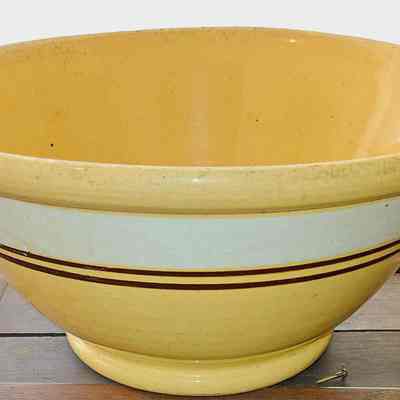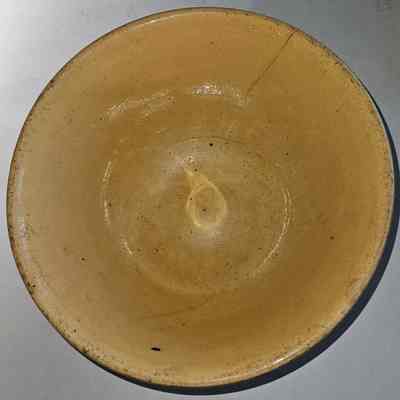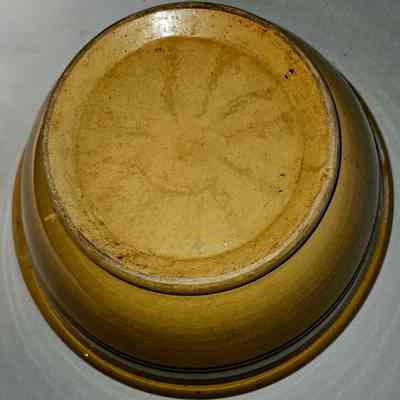Name/Title
Ceramic Yellowware Mixing BowlEntry/Object ID
2024.58.01Description
Large yellowware ceramic mixing bowl. Yellow with white and brown bands. No maker's mark. Based on its shape, colors, and lack of a maker's mark, it was likely produced in the late 19th or very early 20th century. It would have been relatively inexpensive in its time, and thus could be found in the kitchens of either the working class or more affluent people.Use
Kitchen use, mainly -- most commonly for mixing ingredients for baking.Context
From Diana, "A Guide to Antique Yellowware Bowls & More," 2018, updated 2022. https://adirondackgirlatheart.com/collecting-antique-yellowware-pottery/.
"It’s fairly clear to see that the term “yellowware” derives from the yellow-hued clay used to create this type of kitchenware that includes mixing bowls, butter crocks, and pudding molds."
"First produced in Scotland in the late 1700s, and later in both Yorkshire and Staffordshire England, yellowware functioned as a workhorse in the kitchen due to its utilitarian shapes and sturdy construction."
"Up until the mid-1800s, America imported all of its yellowware from England. But after this point potteries in Ohio, New Jersey, and Maryland began producing the popular wares after discovering ready supplies of yellow clay."
"Initially bowls would have been thrown on a potter’s wheel, but most of the bowls and other pieces of yellowware found today were made in molds. You can find coloration from buff to mustard yellow, depending upon where the clay was dug."
"Potteries typically sold bowls in sets of graduated sizes, from as large as 18″ down to 4″ in diameter. You could find sets with up to twelve bowls(!). The largest and smallest sizes of any given set tend to be the most difficult to come by."
"The earliest pieces of yellowware were hand thrown, unmarked, undecorated, rimless, and footless, while newer pieces reveal the opposite: molded, marked, decorated, rimmed, and footed."
"Yellowware was produced in America for about 100 years, from 1830 to 1930. Because manufacturers in both England and the States failed to mark most early yellowware, it can be very difficult to ascertain either a country of origin or date of manufacture."
"Colored bands are one of the most common types of decoration one finds on yellowware. Potters add bands by pouring dyed slip (watery clay) on pieces as they turn on a wheel."
"The color provides a clue that can help determine the age of a piece. Here are some general guidelines:"
"Brown: Mid-1800’s-1900
Blue: Mid-1800’s – 1900
White: Mid 1800’s-1900
Blue & Brown: Late-1800’s-1920’s
Pink/Mauve: 20th century"
"The shape of a bowl’s rim or lip can also help determine its general age. A smooth rolled rim curved slightly outward signifies an earlier lip, while a collared rim or “shoulder” dates to 1900-1940."
"The earliest yellowware bowls, primarily hand thrown tend not to have a base, while later examples do."
"In most cases, especially with earlier pieces, manufacturers applied a clear glaze, allowing the clay’s yellow color to shine."
"However, if you apply a colored glaze to the clay, it results in yellowware in a variety of colors, including blue, Rockingham, apple green, and pink."
"The glaze used on many pieces of yellowware pottery contains lead."
"Yellowware is a type of earthenware and is therefore not quite as durable as stoneware or ironstone."Collection
Shimchick CollectionMade/Created
Manufacturer
UnknownDate made
circa 1880 - circa 1920Time Period
19th CenturyInscription/Signature/Marks
Lexicon
Nomenclature 4.0
Nomenclature Secondary Object Term
Bowl, MixingNomenclature Primary Object Term
Container, Food PreparationNomenclature Sub-Class
Food Preparation EquipmentNomenclature Class
Food Processing & Preparation T&ENomenclature Category
Category 04: Tools & Equipment for MaterialsColor
Yellow, White, BrownLocation
Location
Exhibit Room
Mill Worker's Kitchen Exhibit* Untyped Location
Main Museum BuildingCategory
ExhibitDate
November 18, 2024Condition
Overall Condition
Very GoodDate Examined
Nov 18, 2024Examined By
Eves, J.Created By
historian@millmuseum.orgCreate Date
November 17, 2024Updated By
historian@millmuseum.orgUpdate Date
November 18, 2024


